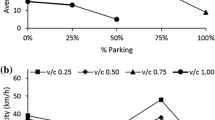Abstract
The Korean government has moved forward with the application of 2+1 roads to mitigate traffic delays and offer safety improvements relative to the two-lane highway. Before beginning construction of the first 2+1 road in Korea, calls have been made to conduct driver behavior studies prior to implementing these roadway types within the existing road network. In this study, experiments using a driving simulator were conducted to assess driver behavior on 2+1 roads. The study results suggest several concepts to be integrated into 2+1 road design in Korea. First, drivers tended to decrease speed suddenly in both critical and noncritical transition zones so that lane changing information system is significantly important in 2+1 roads. Second, the speed change patterns on the 2+1 roads were different for driver ages, with greater variations in speed by older drivers. Third, the locations of speed reductions are related to the passing lane lengths. Sufficient passing lane length is necessary to increase capacity and may offer safety benefits based on the driver behavior analyses. Fourth, inappropriate design of a passing lane can lead to traffic operational problems, especially for older drivers. Finally, safety treatments including median-delineators should be considered in bad weather conditions including snow.
Similar content being viewed by others
References
Banks, V. A. and Stanton, N. A. (2015). “Contrasting models of driver behavior in emergencies using retrospective verbalizations and network analysis.” Ergonomics, vol. 58, no. 8, pp. 1337–1346. DOI: 10.1080/00140139.2015.1005175.
Bergh, T., Carlsson, A., and Moberg, J. (2005). “2+1 roads_ with cable barriers-A SWEDISH a success story.” the Preceding of the third Symposium on Highway Geometric Design.
Chae, C. D., Lee, D. M., and Cho, H. S. (2013). “Evaluation of 2+1 Roads Application to Improve Rural Two-Lane Highway in Korea.” International Journal of Highway Engineering, vol. 15, no. 3, pp. 85–92. DOI: 10.7855/IJHE.2013.15.3.085.
Deller, J. (2015). “The influence of road design speed, posted speed limits and lane widths on speed selection: methodology for simulator and observational research study.” The Proceeding of 2015 AITPM Traffic and Transport Conference. Brisbane, Queensland, p. 12.
Dijksterhuis, C., Lewis-Evans, B., Jelijs, B., de Waard, D., Brookhuis, K., and Tucha, O. (2015). “The impact of immediate or delayed feedback on driving behaviour in a simulated Pay-As-You-Drive system.” Accident Analysis and Prevention, vol. 75, pp. 93–104. DOI: 10.1016/j.aap.2014.11.017.
Ding, H., Zhao, X., Rong, J., and Mab, J. (2015). “Experimental research on the effectiveness and adaptability of speed reduction markings in downhill sections on urban roads: A driving simulation study.” Accident Analysis and Prevention, vol. 75, pp. 119–127. DOI: 10.1016/j.aap.2014.11.018.
Herrstedt, L. (2001). 2+1 roads-Danish experiences, Danish Transportation Research Institute, Copenhagen, Denmark.
Lee, D. M., Chae, C. D., Cho, H., and Lee, S. K. (2013). “Estimated design service traffic volume for 2+1 roads based on Korean twolane highway conditions.” Journal of Korean Society of Transportation, vol. 31, no. 2, pp. 3–10. DOI: 10.7470/jkst.2013.31.2.003.
Lee, S. K., Kim, Y. R., Moon, J. P., Choi, J. S., and Kim, T. H. (2010). “Operational analysis of 2+1 roadway and its use in developing geometric design standards in S. Korea.” 4th International Symposium on Highway Geometric Design, Valencia, Spain.
MOLIT (2010). Research report: Development of design guide of Korean 2+1 roads, Ministry of Land, Infrastructure, and Transport.
MOLIT (2012). Korean highway capacity manual, Ministry of Land, Infrastructure, and Transport.
MOLIT (2013). Research report: An analysis of driving safety on 2+1 roads based on driver behavior analysis, Ministry of Land, Infrastructure, and Transport.
Risto, M. and Martens, M. H. (2014). “Driver headway choice: A comparison between driving simulator and real-road driving.” Transportation Research Part F: Traffic Psychology and Behaviour, Vol. 25, No. A, pp. 1–9. DOI: 10.1016/j.trf.2014.05.001.
Sandle, I., Barry, A., and David, H. (2005). “Wide single 2+1 carriageway in the U.K.” Preceding of the 3rd Symposium on Highway Geometric Design, Chicago, IL, USA.
Szagala, P. (2005). “Analysis of 2+1 Roadway design alternative.” Preceding of the 3rd Symposium on Highway Geometric Design, Chicago, IL, USA.
TRB (2003). National cooperative highway research program, research results digest: Application of European 2+1 roadway designs, Transportation Research Board.
Author information
Authors and Affiliations
Corresponding author
Rights and permissions
About this article
Cite this article
Lee, D., Lim, J. Driver Behavior Analyses of 2+1 Roads based on a Driving Simulation Experiment. KSCE J Civ Eng 23, 1351–1359 (2019). https://doi.org/10.1007/s12205-019-0593-1
Received:
Accepted:
Published:
Issue Date:
DOI: https://doi.org/10.1007/s12205-019-0593-1




